WHERE'S THE BEEF?
Some years ago one of the burger chains ran a TV ad featuring your grandmother -- a nice little ol' lady who sidles up to the counter with a cane in one hand and a burger in the other, opens up the bun, smiles into the camera and in a loud voice, demands "Where's the beef?" Is it just me, or should we ask the art world -- you know, the art world -- our fun, hip and educated slice of society that claims all sorts of inclusiveness and awareness of "other," sensitivity to race, women and gender issues et al. -- should we ask it the same question these days: where, indeed, is the beef -- the image of men-- these days in galleries, in museums, in the magazines? The artwork itself may very well be out there, but getting to see it is another question altogether. And, at the same time, in classic double-standard fashion, the depiction of women's bodies can be so prevalent that, in some museums and issues of some of the magazines in particular, you feel as if you've been ushered behind the red velvet rope of some tits and ass show, with nary a hairy nor smooth dude in sight. This reluctance to depict the male body-- erotic or otherwise-- may merely be business as usual, and a long list of "granteds" (granted this, granted that) may also be at work, but the reluctance does have, I think, unintended consequences which are overdue to be addressed.
To be clear, I am talking about a type of image, male or female, that depicts an arguably attractive body in some state of undress, subsuming an entire genre of representational work that in the past might have been called "nudes" (in alignment with the many university art department classes offered in life drawing), but can also be considered by many to be "erotic," a type of image that signals sensuality and oftentimes desire, and that can be merely a trope for some artists, while a birthright for others, a muse, a mother of all creation. To the credit of the aforementioned art world's inclusiveness, some of the erotic imagery out there dances well out onto the pornographic floor, but again in either mode men are barely to be seen (pun intended), while women -- you might as well call it all Babes R Us.
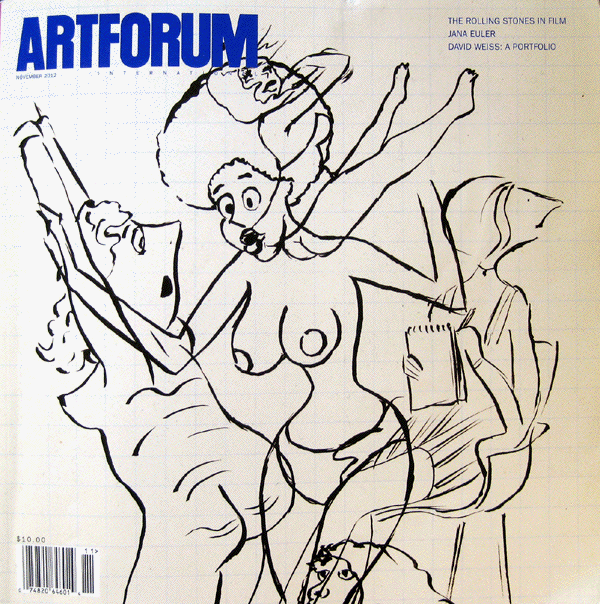 ArtForum
cover, November 2012
ArtForum
cover, November 2012
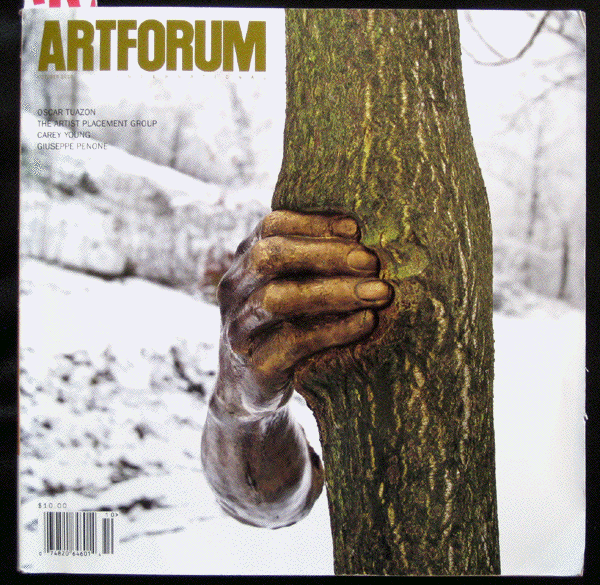
ArtForum cover, October
2010
Take a look first at the magazines. You know, those monthly compendiums of commercial gallery advertising, news, articles (written in a range from digestible to not), and waiting-in-line-at-the-checkout-aisle fluff. Written to a range of readers, from the neophyte collectors Art News (now defunct) seemed to favor, to a broad spectrum of artists and insiders addressed by Art In America, to a more conceptual crowd reading Art Forum, these magazines (and others), while not usually appearing in the supermarket magazine aisle, still act as the art world's ambassadors. Regardless of where you live, and especially if that "where" is not in or near an art-hive such as Brooklyn, Culver City, the Mitte (Berlin), et al., where regular gallery-hopping is actually feasible, there it appears in your mailbox offering you, in tip-of-the-iceberg fashion, a glimpse of what's going on. As an artist, I personally find the images in their advertising to be valuable because I don't live in a gallery-prone area of the country, despite the fact that those ads reflect only those wealthier galleries that can afford $6000 (in 2017) for a full-page, full-color ad (back in 2007, before the market bubble burst, the rates at Art Forum were $5000 per page, and one issue weighed in at a whopping 540 pages). So instead of going to a lot of galleries, I go through a lot of pages -- and with a discipline that is very unlike a casual flip-through, since I am paying attention not only to content but graphic design and layouts too that can offer poetic echoes and jarring juxtapositions alike when it comes to color, imagery, typeface, etc. -- in all, on levels that never happen on a website where not only do I ignore flashing advertising and pop-ups, I am much more in control of which pages and hypertext links to idiosyncratically click on next. Because this is a slow process and I usually don't go through any single issue in one sitting, it took quite a long time to realize what I was seeing (or more accurately not seeing) when it came to images of women vs. images of men -- babes aplenty vs. nada.
Part of all this can be explained, of course, by the "granteds," issues of economics and also demographics. Galleries paying big bucks hope to bring in clients (this month or eventually) who will ultimately put down their own big bucks in the form of purchases. Images of women have always been used to sell things and services, whether said goods have something or nothing to do with female beauty (OMG, sex sells!) The art mainstream is still dominated by various male hierarchies, and since most men are heterosexual, they enjoy looking at female images in the advertising and the art. Plus, the many publications and other media destined for women-- on health, beauty, fashion, the home, family -- certainly surround women with images of themselves, so those perusing any art magazine or even art museum will barely notice anything amiss, odd or out of place. And on top of it, artists and others who may be critical of the objectification of women to be found throughout this culture tend to promulgate, in protest, still more images of women.
xx
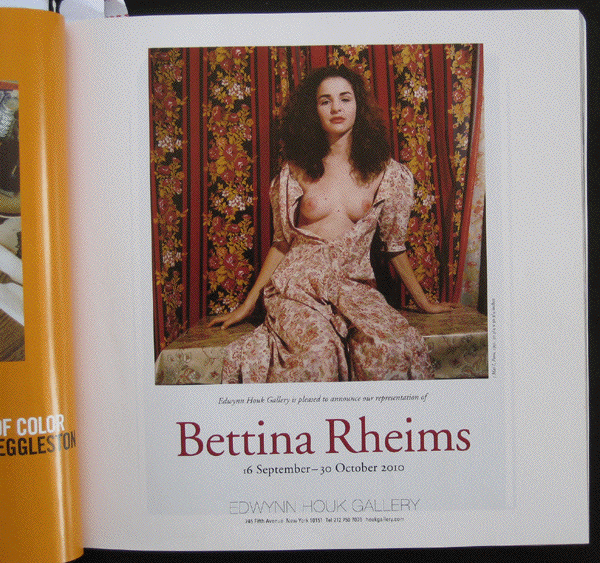
Ad, Bettina Rheims
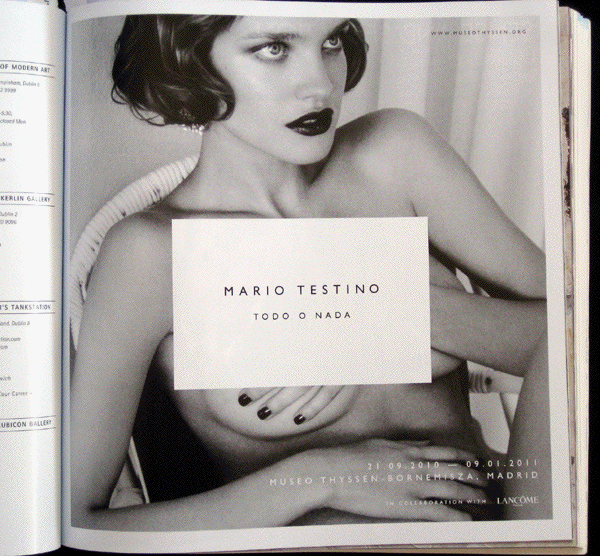
Ad, Mario Testino
We all, of course, have been inured to being surrounded by images of women since time (or at least our personal time) began, be it the scantily clad sales pitch or the langourous nudes of the gentlemen's club (or museum). I've taken life-drawing classes myself where the model was almost always female, and even taught such classes while being careful to split the model lineup equally between women and men. So, a large part of me has been so used to seeing naked women around and out and about, that again it took a long time before I started to think-- you know what? I'm an artist who likes to paint images of men, and it's about time I start seeing lots more images of them in my local/ global art world, part of today's landscape. Parity, right? Really, where's the beef?
While egregious magazine examples continue to abound, my personal tipping point came with the October 2010 issue of Art Forum. With merely 308 pages, it's still not an amount of content you're going to remember even ten percent of by the time you are halfway through it. And yet, once you are sensitized to this imbalance I am speaking of, the first few pertinent images flag themselves in your head and you wind up being on alert, for better or worse -- i.e. asking yourself if this issue is going to wind up pissing you off -- every time you turn the page. Perhaps it would fulfill the research desires of some sympathetic future Ph.D candidate or Richard Prince or Richard Phillips wannabe to track, via page-spread thumbnails, columns of female images vs. male images in all the magazines that come in over some span of time, though I will admit that in some months there are not that many images at all for either column, in which case he or she would have to track on a yearly schedule. But for this particular 2010 issue at least, this is what the count looks like:
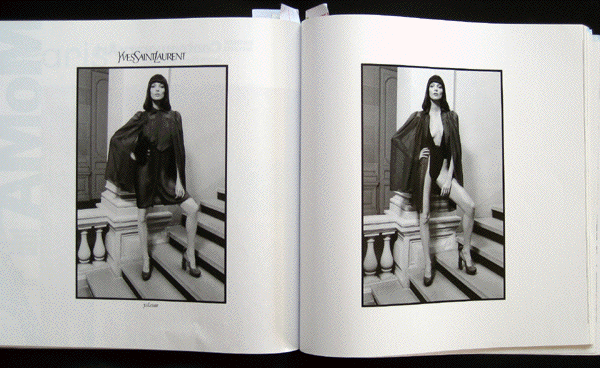
Ad, Yves Saint-Laurent
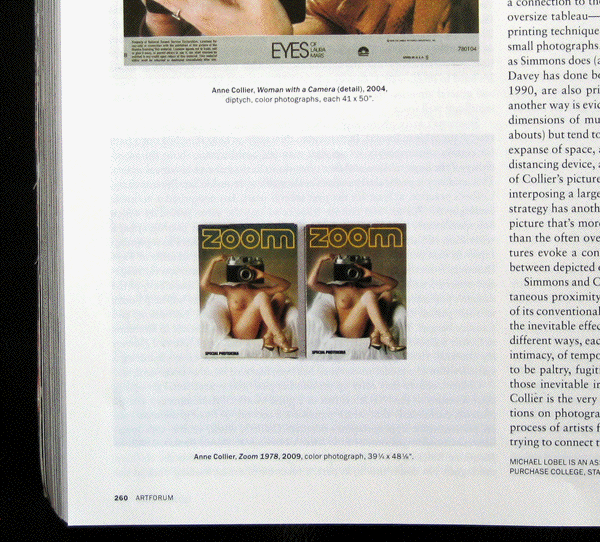
Feature, Anne Collier
BABES:
Ad, Acquavella: Picasso female nude
Ad, Edwynn Houk: Bettina Rheims female nude
Ad, 1stDibs.com: more Picasso, and bare breast study (Stieglitz?)
Ad, PPOW: Bo Barlett clothed woman with big knockers
Ad, Heritage Auction: Herb Ritts female nudes (2)
Ad, Museo Thyssen-Bornemisza: Mario Testino female nude (tastefully
cropped)
Ad, Palais de Tokyo: Adam McEwen hot babes in couldn't-be-shorter
shorts
Ad, Yves Saint Laurent: 6 pages! of a leggy brunette
Feature, p. 248; Monte Hellman, woman in lingerie (back view)
Feature, p. 250: Monte Hellman, bare babe and monster
Feature, p. 260: Anne Collier, naked chick on 'zine cover (twice)
Review, pp. 270-71: Renoir, 3 paintings displaying 7 naked women
Review, p. 293: Adriana Lestido, 2 women in embrace (nude?)
BALLS:
But no balls are to be seen. Alas, there is only a single image
of male flesh we get --
an ad for Urs Fischer in the first few pages: Michelangelo's
Pieta (Christ, no doubt, draped, and that giant pushpin stuck
into his crotch -- ouch that hurts!)
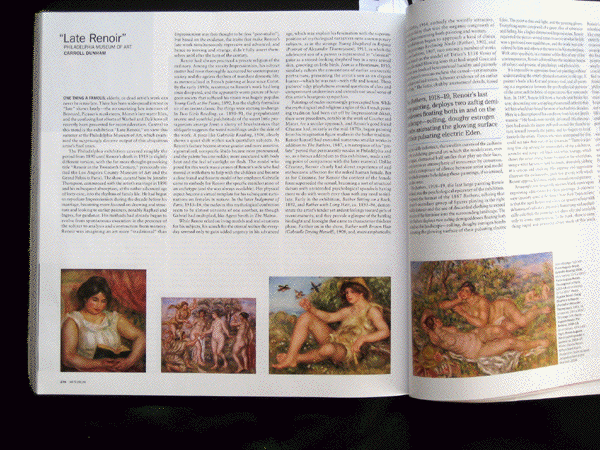 Review, Renoir
Review, Renoir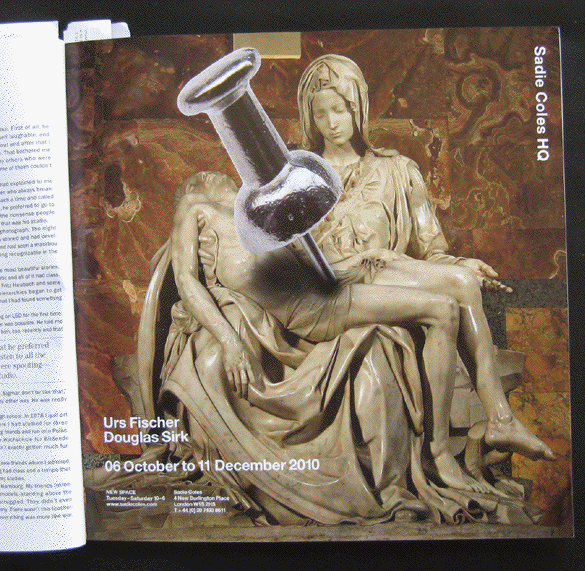
Ad, Urs Fischer
The imbalance is laughable, and to add insult to injury, on p. 294 in the review of a controversial show in heavily Catholic Poland explicitly titled "Ars Homo Erotica," in which there was "an omnipresence of (homoerotic) naked bodies," ArtForum has reproduced an extremely chaste image of two fully-clothed gay boys holding hands. OMG! Granted, given the context of that exhibition, this image by Karolina Bregula is powerful and worthy of reproduction if only to demonstrate how so tame an image could so upset the poles of Poles. But wait! There, just before the issue ends, there on p. 298, is an ad for Artforum's own online Diary, with an image of a smooth dude sans shirt. Finally! And it turns out to be none other than Iggy Pop singing with his shirt off, (looking really ripped for someone 64 years old!) acting as the other male bookend (along with the even older Michelangelo) to corral the aforementioned rodeo of babes and vixens. Needless to say, my keyboard erupted in hot spurts as I e-penned a missive to the editors, saying some of the things I've just mentioned to you, but then I went further:
"It seems astounding that in a world of roughly 50% men and 50% women and where roughly 95% are heterosexual, the reader sees image after image of women, as if the only artists out there are heterosexual men who get off putting nekkid babes into their work (as they have gotten away with for only a few centuries). But images of men -- that some of those women might very much enjoy seeing --? By women artists? By gay artists? Forgittaboudit. To this day I've yet to discover in any magazine, including ArtForum, if Charles Ray's Boy with Frog at the 2011 Venice Biennale is anatomically correct -- as if the magazines are reinforcing the idea that male bodies are either taboo or else men are too fragile to witness depictions of their private parts - so no pix allowed of Frog Boy below the waist. (And indeed, when I happened to visit the Getty last fall in Los Angeles, and there outside on the main staircase going up from the tram station is Frog Boy standing completely naked, it turns out the sculpture is indeed anatomically correct and probably earning a photo from one visitor out of three, despite it being a bit roped-off). This double standard (women are hot; men's bodies = taboo) surfaces even in the language used to talk about images. When women are depicted nude, it goes without saying that such images can have erotic potential, and it seems to be presented as "this is just a part of life" -- this is normal for artists to do/ think about/ etc., a reflection of society sort of like having a Golden Retriever or a burger and fries. (One wall tag at the Art Institute of Chicago, in talking about a Max Beckmann painting, says-- and this is typical of the genre-- "Reclining Nude recalls the long-standing tradition of associating the female body with the timeless ideals of beauty.") The depiction of similarly posed men, on the other hand, is often clearly labeled, in many venues, as "homoerotic"-- almost as if it's a warning. (Have you ever seen, let alone used, the word "heteroerotic"?) A warning as if to say: "Caution, any ingestion/ enjoyment of this image on an erotic level may induce others to think that you, the viewer, are a faggot." "
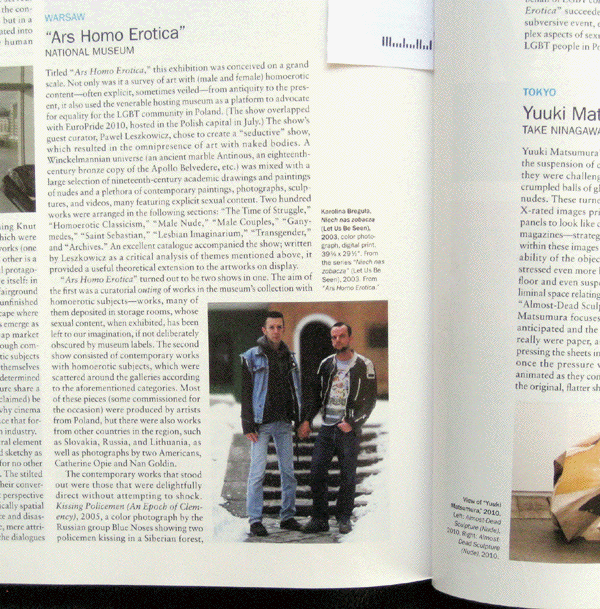 Review, Ars Homo Erotico
Review, Ars Homo Erotico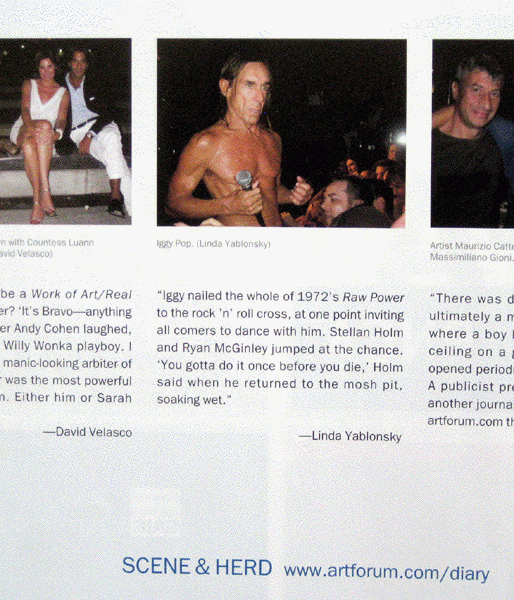
Ad, ArtForum Diary
Art critic extraordinaire Jerry Saltz was onto something a few years back, when he started pointing out (leave it to a pointer) regularly the dearth of women represented in museum collections and large group exhibitions such as the Whitney Biennial. He was, of course, taking his cue from the Guerrilla Girls, a collective of anonymous female artists creating confrontational artworks and advertising directed at the same exact point. Saltz's oft-repeated comments in the art press -- which, like the GG's, actually tallied percentages of the gender divide (70% men, 30% women, etc.), whether in the Village Voice, New York magazine, or other publications, and echoed by his wife, esteemed New York Times critic Roberta Smith, have had staying power, and many would say that today, in 2013, all these dispatches of sensitivity training have borne fruit where it does count -- on the institutional level of major (and lesser) museums, to the point where gender is an awareness at least on the imagined horizon when planning exhibitions, just as, one has assumed for years, ethnicity and national origin are as well. In fact, the 2012 Biennial was the first where men and women were equally split.
Aware of Saltz's repeated admonitions of gender imbalance, I did send a copy of my letter on to him. The very next month, in the New York Times published November 12, 2010, his wife Roberta Smith mentioned parenthetically in a review of 2 painting shows titled "Playing the Renegade with Eroticism or Rage," (that) "I refer to the uproariously erotic (IF PREDOMINANTLY HETEROSEXUAL) (my caps) display of William N. Copley's 'X-Rated' paintings from 1973-74 at the Paul Kasmin Gallery in Chelsea, and the take-no-prisoners, fluorescent-hued canvases of Peter Saul, seen in a brisk 50-year survey at Haunch of Venison in Midtown."
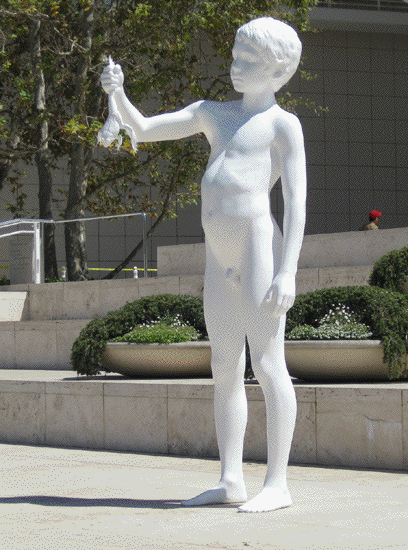
Charles Ray, BOY WITH FROG
at the Getty Center, Los Angeles
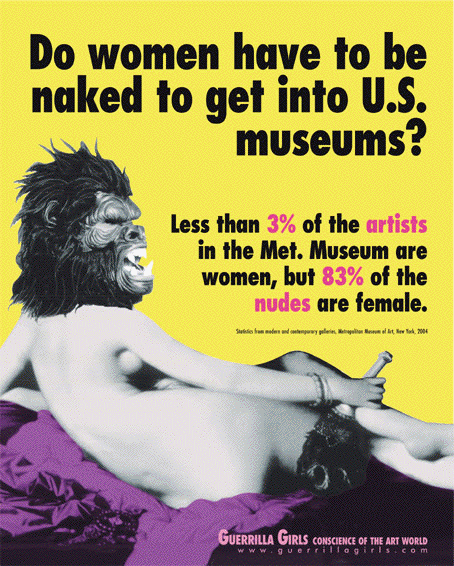
Guerilla Girls Poster
It was heartening indeed to think she may have taken my cue. But the more I thought about this polite term "homo-erotic," a term I had used for years and continue to do so usually out of habit, the more I came to realize how self-segregating and actually inaccurate it really is. As I very recently mentioned, it signals "other" in a larger context, maybe a warning, maybe provides you an excuse to pigeonhole and overlook, graze past or ignore completely. It could be used in a fair way, if it were used opposite the term "hetero-erotic," instead of paired with the non-prefixed "erotic," a term that in its historic shorthand infers the culturally dominant heterosexual. But even if this inflation of terminology were accomplished, its usage can still be largely inaccurate, in that the terms really are assuming something about the sexual preference of the viewer, as opposed to the sexuality of the subject, if that subject is a single isolated person. Take, for example, an image of you -- just you and you alone-- with your shirt off. Do you look hetero-erotic or homo-erotic? Maybe it depends on the day, but obviously the term is meaningless, or unassignable. If anyone claims it's either, the claim really is assuming the sexuality of someone else LOOKING AT the image, not the sexuality of the sitter him or herself.
Several years ago I was having lunch in the historic, southeastern Arizona mining town of Bisbee. Across the street from the cafe is a poured-concrete, copper-clad statue of a well-muscled, shirtless miner holding a sledgehammer, made in 1935 by Raymond Philips Sanderson. I was definitely enjoying the view out the window, while at the next table were four women in their thirties. They too were enjoying looking out the window at this fellow, when one of them says to her friends, "I just love a man with a big tool." We all laughed. If I'm looking, the statue is homo-erotic? And if those women are looking it's hetero-erotic? Might it not be simpler to keep the focus of terminology on the verifiable subject and say "male-erotic" rather than deal with its changeable audience? Even if there are two or more people engaged in some sexual exchange within an image, the appropriate term can be elusive. Two women having sex with each other in an image might be considered homo-erotic by many, but if men enjoy looking at such images, as I know some do, what then of the terminology? Should it be called homoerotic with heteroerotic crossover capability? (That would be Ho-Het-Cross-Cap for short.)
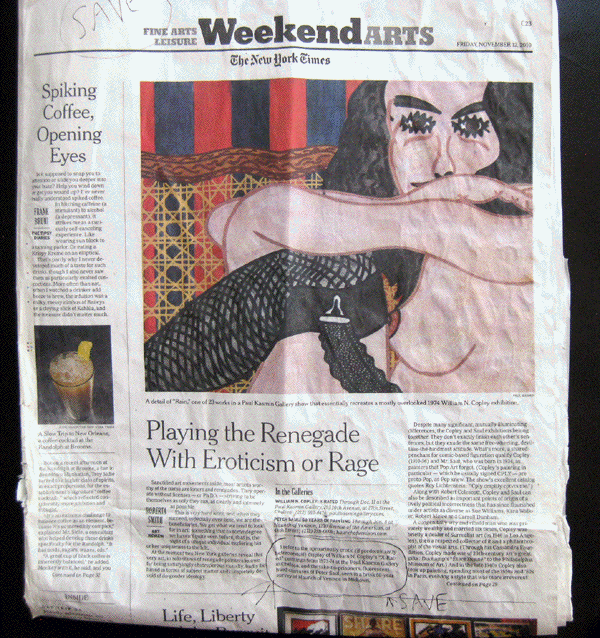
New York Times article, November 12, 2010
by Roberta Smith
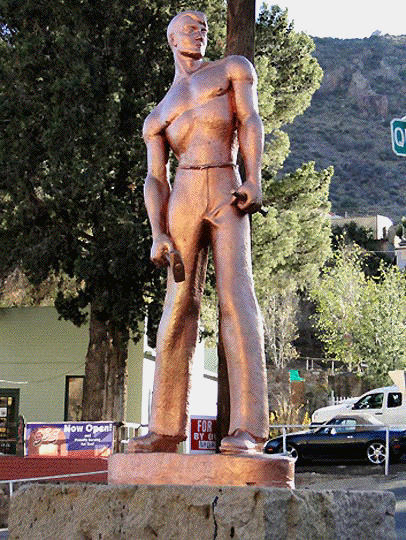
Raymond Philips Sanderson
Miner statue, Bisbee, Az.
I can see some of you rolling your eyes, asking at this point what does all or any of this matter? Some of this wordplay here is intentionally silly, to push the point that certain labels are not necessarily accurate. Consider the migration of the term "negro" (or worse), to "colored," to "black," to "African-American," a polite term used as shorthand that is meant to include include neither Arabs nor whites from South Africa, or even present-day immigrants from Nigeria et al., but rather only those black Americans descended from the legacy of slavery in this country. This linguistic shift did not stop black Americans in the 1970's from demanding visibility in mass-audience magazines such as Life and Look, as up until that point they had been segregated into magazines (which still are published today) such as Ebony and Jet.
In my mind, using the term "homoerotic" is self-ghettoization. Gays accept this term out of deference to a larger, perhaps scared, society; we take this pink triangle assigned by Nazis and eagerly want to spiff it up a bit, make those points sparkle. For some gay artists, their work has nothing iconographically to do with anything recognizably gay (eg. Ross Bleckner, Robert Gober, Robert Rauschenberg), and this is as it should be -- it's their prerogative, whether they are from a time when an admission of homosexuality also brought you admission to the local jail, or whether they are from these post-gay times. But for those male and/or gay artists who do want to refer visually to their sexuality, or in some way have it merely included, the post-gay times aren't quite here yet. What I am saying is that the work not only should be tolerated and accepted, it should be visible as part of that de rigueur burger-and-fries landscape. To quote a recent AP article on "gay-themed ads moving into the mainstream" (March 9, 2013), "For the gay consumer and their families and friends, and lots and lots of Americans, they expect to see those couples appear everywhere, but they don't want them trotted out with a pride flag." I don't know if it's possible to stress this point enough, as it is essentially my point here. Male imagery needs to be out there in the (art) world on a par with female imagery; and even when it may be erotic in nature, it does not need to draw over-attention to itself by some elaborate mechanism of linguistic roping-off. The larger society has been changing, and those who appreciate such imagery aren't hiding anymore; in dollars and cents, audiences are changing too, and merchants need not continue to be so cautious.
Who goes there-- friend or foe? It may sound a bit simplistic, but maybe we can start asking this of ourselves and allies once in awhile. In an art world filled with gay artists, gay gallery owners and gay museum people, I would venture that some of us are perhaps unconsciously propping up the status quo. For instance:
----- 1) Several years ago, at the San Francisco Museum of Modern Art, I was touring an exhibition of parts of the Logan Collection, a collection that contains a number of my works but which were not in this particular show. I was accompanied by the assistant to the curator, the curator being Madeleine Grynsztejn, now in 2013 the director of the Museum of Contemporary Art in Chicago. Her assistant and I were looking at Takashi Murakami's large female sculpture "Hiropon," a large and largely naked young woman spurting a hula hoop of milk from her breasts, prominently exhibited in the gallery. I asked where the companion sculpture was and which I knew was part of the collection, a naked young dude with a geyser-lasso of cum spurting from his big erection, titled "My Lonesome Cowboy" and reproduced in the very spiffy catalog. The assistant laughed and said, "Oh, we didn't think our audience could handle it." Excuse me? We are in downtown San Francisco, smack dab in the middle of a decades-old magnet and homeland of gay culture in the United States and you don't think your audience can handle it? Oh really? Oh my...!
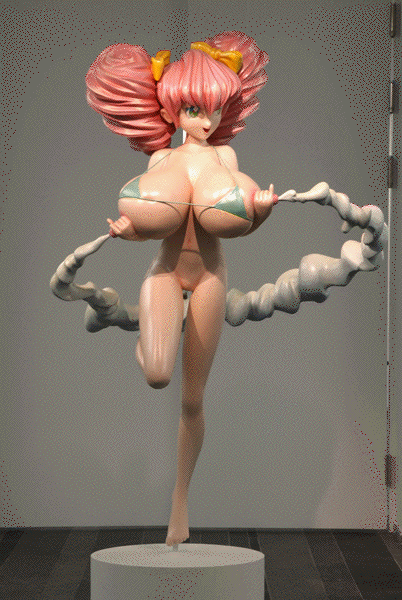
Murakami's HIROPON
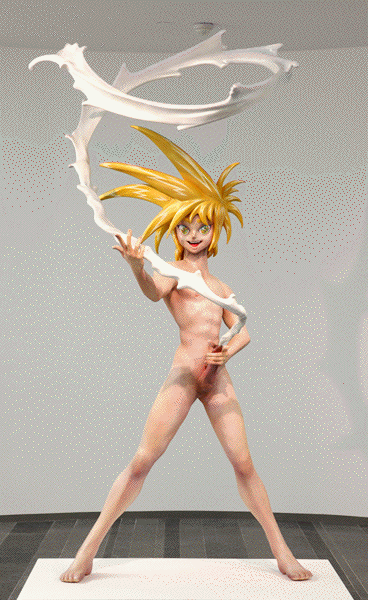
Murakami"s MY LONESOME COWBOY
----- 2) Last fall I am talking about my paintings with one of my gallery dealers. It has been almost 5 years since my last solo show with them, though they gave me seven solos between 1991 and 2005. They point out that their space is now larger, they have to coordinate the visuals more closely, but they are making no noises about planning another show. They convince me they are on my side and have always liked the work and only want to help, but feel my imagery is too male-dominated of late. I had already been informed that there are only so many images of shirtless men they can sell to a client base of predominantly straight couples. I had also been told that if I still needed to paint guys, they would recommend painting them in not more than one painting out of three. As we sat there discussing my take on the term homoerotic, they led me to believe that even a painting with two close-up men's heads would fall into that category, and I started to wonder what they might consider Mount Rushmore? And the whole time I am sitting there for 45 minutes, in my sightline and 20 feet behind the director is a bronze and colorfully painted statue of a naked young woman by Manuel Neri.
----- 3) Two months ago on FaceBook I have a message exchange with an art critic who is gay and has reviewed my work in the past. He has posted an image by a local photographer from the 1980's whose work he had long ago described as homoerotic. I tell him about my objections to the word, and send him an image of the miner statue in Bisbee. He responds: "I understand that you have a dog in this fight, and I had never thought enough about the term to see it as being a warning, or as making a negative comment on something. But I do think it has meaning and from my perspective, the Miner Statue is undeniably homoerotic--not that it only appeals to gay men, but rather that the artist captured the man's erotic soul. From my point of view when I call an object homoerotic, I'm referring to the subject, not the viewer." In response I send a photo of a 20-foot-high concrete relief sculpture of a completely nude family -- i.e. a husband, wife, infant, two daughters and a son-- on the outside wall of an insurance office building, facing the sidewalk and across the street from the Nebraska State Capitol building in Lincoln, asking which term he would use in this case. I do not hear back.
----- 4) Some years ago, I have an email exchange with the openly gay and current director of a major U.S. contemporary arts museum. He has, in fact, purchased one of my paintings of an erotic ilk, but he mentions in the email that I should not assume his own personal tastes influence the programming choices he makes for his museum.
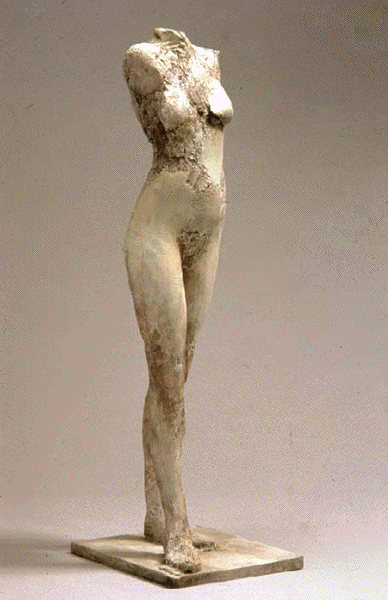
Manuel Neri painted
bronze sculpture
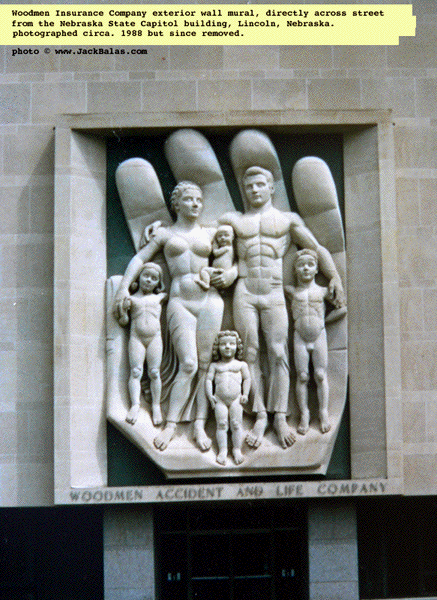
Woodmen Insurance
Company
Public wall sculpture, Lincoln, Nebraska
Granted, this all may right itself over the coming years. The world has undoubtedly changed since the internet came along, making works and communities easily visible if still only virtually accessible. We are already seeing the end of some hard-copy magazines. As gay families and the prospect of marriage move the gay community as a whole better into the mainstream, acceptance will grow and along with it higher visibilities of certain types of images. (It's already been delightful to see gay-themed ads appear, going back several years, from the ubiquitous shirtless dudes in bars ordering up another Miller or Bud Lite, to the two boys in disco gear sitting on a pile of tires listening to Bridgestone tell them "You Know How to Accessorize!"). But the prejudice against the male erotic is still prevalent and needs to be challenged. Perhaps the least prejudiced are the museums, who, nevertheless, display the nude female in great numbers (see Guerrilla Girls, above) and, when they do choose to display older, safer male nude favorites like Rodin or Thomas Eakins, have the perfect context-- i.e. all of history-- in which to draw our minds to the ideal and away from the thought that this St. John the Baptist in the Wilderness dude might actually be the local fireman we see on occasion barbeque-ing in his backyard, or that the group of naked boys in Degas's Young Spartan Girls Challenging Boys are the namesakes of the high school wrestlers and football team just down the street. Thomas Hart Benton's Susanna and the Elders never is questioned, while Grant Wood's naked farmer dousing himself with a bucket of water in some hot dusk-- the uproar that created! And that uproar intensifies along with various forms of censorship when the naked male arrives in public art today, sans loincloth and sans context. Eric Fishl's bronze of tennis great Arthur Ashe survived its controversy, but not the same can be said of a group bronze of 2 female and 1 male entwined dancers in Loveland, Colorado, originally sited in a suburban traffic circle where OMG children! children! could see this guy's cock and balls buffeted by the wind, and was since moved to a "less exposed" location so as to do what? protect children! from the thought (before they are 18) that people, under their clothes, are really naked? Or there is the "Tucson Solution," in which the city this spring installed, just north of downtown in a very well-trafficked pedestrian area, 2 bronze nudes signifying whatever (music? shopping?). The original commission was for both a naked female and naked male figure, one each, doing their thing, but when cost overruns came to bear (I am surmising), the city (or the artist) simply cast the female figure twice and decided to skip the dude.
Am I suggesting we objectify men in all of this? While I'm aware of many legitimate concerns when it comes to the widespread objectification of women across many media, not to mention in broader society, I do wonder if turning the tables on men might not be a bad idea, at least to a point. If in 2013 the Palm Springs Art Fair can celebrate and honor with a special exhibition Mel Ramos, an objectifier of women if ever there was one, might it not hinder the worst offenses if men got a taste of the problem themselves? I can personally testify to the fact that, in locker rooms today, guys have gotten way bashful about taking the group showers that used to be the norm, demanding little privacy booths with curtains, and if they're slipping out of a wet swimsuit they are wrapped in a towel while doing it, as if they are surfers along the Pacific Coast Highway. They know there are so many cellphones with cameras around (no, I do not have a camera on my cellphone), and they know that otherwise they might wind up on some nude lockerroom website in the blink of, well, a blink. And if they are the men who have been doing (or enjoying) the objectifying, well, they are learning what that's like.
Would I advocate the mindless insertion of male beefcake images into the art world's press? Not really, unless it was the only way to counter the mindless cheesecake imagery already out there. I would, however, advocate more, or more visible, male (and female) imagery that goes beyond shallow surface depictions. One early reader of this essay asked what would happen if the taboo against depictions of male nudity suddenly vanished. Certainly their power due to rarity -- which does include some shock value-- would fall away. But perhaps their relevance to our own lives would increase. Many images would simply reflect our daily lives, for sure, while offering us a different take on people. But it's when images venture beyond the everyday, towards something perhaps metaphoric or spiritual or even mythic, that a real attitudinal adjustment can take place: we start to wonder how some Joe we know can also be mythic at the same time. We may sense the attempt by Thomas Eakins to construct something heroic via the everyday, in his paintings and photos of swimmers at a swimming hole, but at the same time we are very aware, through records, that they include self-portraits while other figures are Eakins's students. And again with Fischl's Ashe: how can he be mythic when we know where he lives and what his favorite foods are and where he vacations? How do we go beyond these particulars in trying to think these guys are timeless if they cut our lawns and work at the tire store? I might imagine local townspeople, in regarding Stanley Spencer's very hot young dude as centerpiece in The Resurrection, Cookham, thinking "How can we possibly have a Resurrection here in Cookham?, or THIS resurrection?" And yet my point is that such thoughts are precisely the ones that we might all be well to engage -- that we don't have to pretend to require epic situations anymore before we can consider and enjoy such images, that people in these depictions are still everyday people with everyday lives before the artist comes along, and that we can wonder what it would be like to step into a role such as "everyday hero" or "everyday saint." Bottom line is, we wind up realizing that, in large part, we - everyday us- constitute these gods. In effect, Saints R Us.
In saying all of this, however, I don't mean to suggest that we only picture ourselves as heroes and saints or wannabes; far from it. What is important, is to have the full range of imagery, the full menu, with all of its day-to-day frequency and visibility. If we only accept images of women to the extent we already have, we all wind up shortchanging how we picture ourselves, just as our continued use of the word "homoerotic" helps delimit our universe, sets boundaries around how we may think about ourselves, and excludes from us some ways we might want to think about ourselves -- not only for gay men, but for all men -- for everyone. Currently an image of a woman is still privileged, still exalted, still held up as somehow representative of the whole, and still controlled by a straight and male power. The message to men, implicitly and deep-down-going, is that we are not worthy of depiction, maybe that we are not capable of achieving something worth depiction, men should not think themselves to be worthy of contemplation, worthy of the idea of beauty.
In the last year I have had a number of gay art students at universities in a few out-of-the-way places befriend me on FaceBook, admiring my work. One recently asked my advice on, to use his words, how to infuse a gay sensibility into his work while sitting in the middle of Alabama. I mentioned this to a friend who happens to live in San Francisco, and he told me he would tell the guy to infuse his ass out of Alabama pronto! I laughed, but inside me a buzzer went off at the same time, the one that signals that such an answer is not allowed. Rather, the real answer, to me, --or actually it's still the question of how --is not how to run away, but instead how to construct that environment where you can live in Alabama or Albany or Alsip or Avondale and find what you need, right there, when you look not only around, but also inside of yourself-- and then to show that to the world. We as humans start learning from day one through example, starting with our parents, while continuing to broaden our horizons. For many of us, we need to SEE ourselves -- i.e. all of these possible images, and everywhere -- before we can BE ourselves.
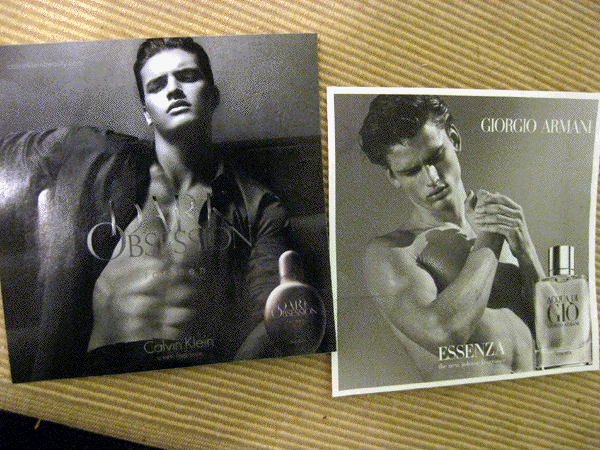
Ad, Calvin Klein & Armani
Two ads came along with the newspaper one morning this spring in sleepy Tucson, Arizona -- fragrance deals from Calvin Klein and Armani. Personally I am not much into colognes, but the shirtless dudes splashing it on -- my god! They are of the now-standard variety of Adonis, widely-seen in this kind of advertising but not to be seen hardly at all in the art world that matters to me quite a lot. My desire to see them there in different, non-commercial guise, though, could describe much of my current work as an artist. Do I look at them with desire? What gay man wouldn't? Do I look at them thinking that that's all they are, their appearance? No, not a bit. But the biggest difference, when I say all of this, is that when I look at them, I don't think of wanting to own them. It's really more like looking at them as an ideal, an inspiration; the goal is not to own them, but to BECOME them. When men look at an image of a woman, I think there is a psychic wall there that ultimately is unbreachable, and the only way to deal with it is to find a way to jump it, to take it over, to own it, or, in terms of sex and marriage, to join it and "forge a new union." As far fetched as it may sound, when men look at images of other men, instead of and despite any idealizations of beauty that may be involved, men actually are allowed to sense that they have a real shot at BECOMING those ideals they may be looking at-- perhaps least of all on the surface level where genes and weight routines would come to bear, but more seriously on those more elusive and deeper levels that conjure one's bearing in the world: self-confidence, willingness to risk, to take the lead, to picture yourself in the world from an outside vantage point and then act (eg. what sports hero is not aware of the impact, as role model, he or she can have on kids when they watch?). This notion of becoming, to me, is worthy of inclusion not only in the art world, but in the broader one which we all share as well.
Ideas are abundant today about the nature of what we consider to be "reality." From quantum physicists arguing that we create our own realities out of an infinite number of possibilities, based on the fact that electrons at the sub-atomic level can be in two places at once and that it is a matter of choice as to what we are going to see and experience; to the thought that thought itself is the basis for reality, that the mind creates matter rather than the other way around; to art critic Suzi Gablik's 1980's essays on the re-enchantment of art in which a new mythic soul-encompassing consciousness is needed (and afoot) among artists who see the role of their images as ambassadors, as shapers of reality rather than mere mirrors of society-- it becomes important, if not crucial, for all of us to be able to see, ponder, and build upon images of all of us, female AND male. How could we pretend, except, sadly, via the lens of commercial consumerism and American puritanism, that anything less is acceptable? When artists posit images, some might say we are looking for answers. Others might say we are looking for the questions. And still others would say of this whole process -- that therein lies our salvation.
Where IS the beef? The cover of the November 2012 ArtForum magazine (image below, left) features a beautiful drawing from 1977 of several naked women by Swiss artist David Weiss. As an alternate cover I propose this one (image below, right) featuring one of my own drawings of a naked and beautiful young man. HERE's the beef. We've met him. And he is us.
Jack Balas
 ArtForum
cover, November 2012
ArtForum
cover, November 2012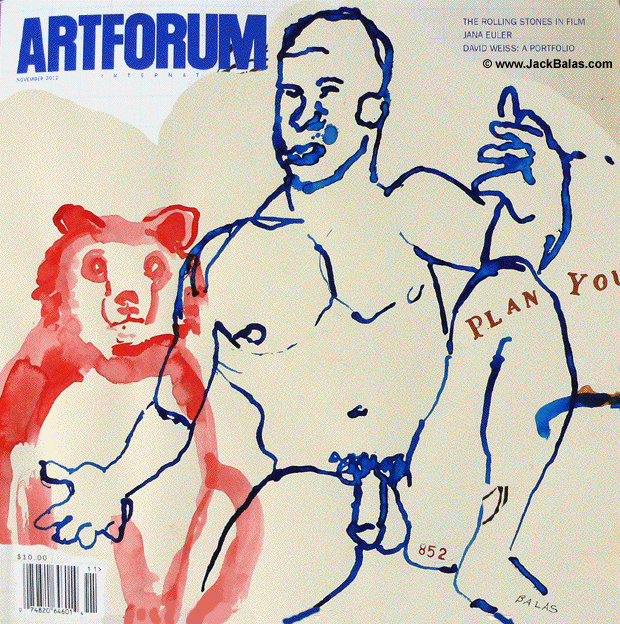
Proposed ArtForum cover, with drawing by Jack Balas
P.S.:
PHAIDON, WE LOVE YOU (NOT).
Shortly after completing this essay,
I received my copy of Phaidon's hefty new and updated compendium
of contemporary drawing, VITAMIN D2. One inclusion therein illustrates
in a major way the major point of the essay, laying out the propensity
to publish female imagery while excluding the male. The artist
in question, Cary Kwok (b. 1975), who divides his time between
London and Hong Kong, first came to my attention a few years
ago with blue ballpoint-pen drawings of young muscled men covered
with spurts of cum. One could argue that they are pornographic,
yet at the same time that they are very "artful" compared
to anything available as a photograph on the internet. Looking
at Kwok's website it is clear, however, that he plies in images
of both sexes. The author of Phaidon's blurb on Kwok, Colin Perry,
lays out the difficulty, then, in representing the work: "If
you were only to see (his) most tasteful exercises in virtuosity--
his ballpoint pen and acrylic paint works depicting intricate
chinoiserie dresses, wonderfully architectural tresses of hair,
ladies' shoes to die for-- you would only have seen half the
picture. For Kwok's most notorious and most striking work is
sheer x-rated porn, with a gleefully irreverent twist: images
of men... showering themselves and each other in great, streaming
jets of cum. Conversely, of course, if you were to only see these
quite literally blue images, ... you would also only have half
the story. ..." What to do? Since Kwok was not featured
in the first edition of VITAMIN D, and since the work is so very
bifurcated, I, for one, might expect them to offer some sample
of both bodies, especially since Kwok is given 4 pages in the
new volume. What did Phaidon do, however? You guessed it: they
devoted all 4 pages (with six images) to those of women (in works
dated 2009-2012). Sadly, LOL. Hey, where's the beef?
JB
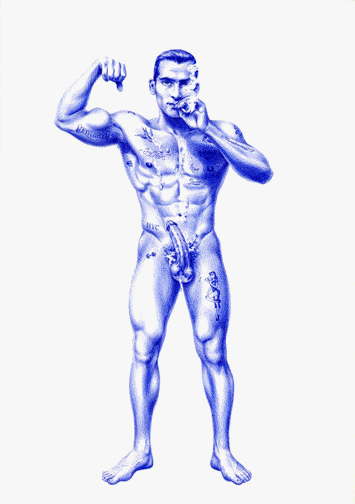
Cary Kwok, 2007, "Well Hard,"
ballpoint pen on paper.
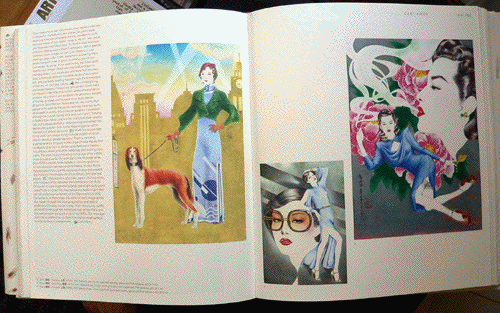
Cary Kwok's pages
in the
2013 Phaidon edition of VITAMIN D2
---------------
An early draft of this essay was
originally presented as a guest lecture at the University of
Arizona in Tucson, Arizona, on April 4, 2013. The author welcomes
inquiries for its further publication or dissemination.